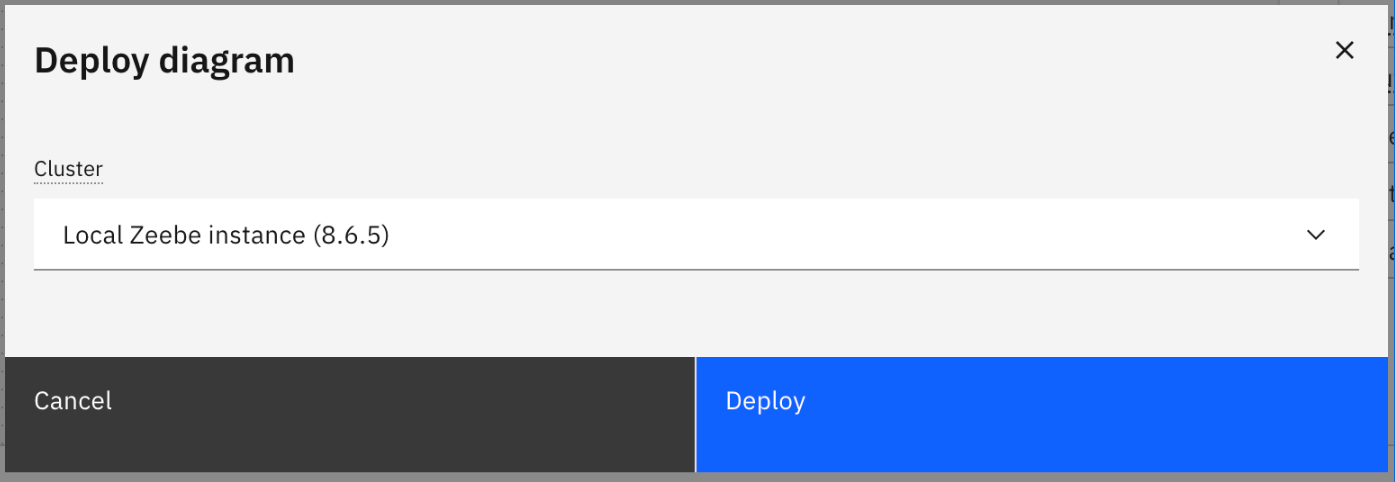8.7 Announcements
Important changes and updates for the Camunda 8.7 release are summarized below.
| Scheduled release date | Scheduled end of maintenance | Release notes | Blog |
|---|---|---|---|
| 8 April 2025 | 13 October 2026 | 8.7 release notes | Announcing Camunda 8.7 |
- Amazon Web Services (AWS) region support
- Web Modeler
- Southeast Asia region for SaaS customers
- Breaking changes in Camunda Process Test
- API updates
- Identity Keycloak now requires v25 or v26
- Camunda Spring SDK now requires Spring Boot 3.4.x
- Zeebe Java client
Amazon Web Services (AWS) region support SaaS
You can choose to host your Camunda 8 SaaS clusters in two new Amazon Web Services (AWS) regions:
- Frankfurt, Europe (eu-central-1)
- North America, Virginia (us-east-1)
You can select one of these AWS regions when creating a new cluster. You can continue to choose from our Google Cloud Platform (GCP) region options.
To learn more about available Camunda 8 SaaS regions, see regions.
The following limitations currently apply for AWS regions:
- Backups are stored on GCP.
- HTTP connectors continue to route through GCP.
Web Modeler
Deploy diagram change Self-Managed
With this version, we ship a breaking change to how Web Modeler Deploy diagram modals work. Clusters must now be proactively configured to be able to deploy from Web Modeler.

- In 8.6, you could still configure cluster details on the Deploy diagram modal when deploying.
- In 8.7, you can no longer configure cluster details on the Deploy diagram modal. You must configure the cluster to be able to deploy from this modal.
- Note that you must also be assigned the
ZeebeIdentity role to be able to deploy.
Milestones renamed to versions
The term "milestones" has been renamed to "versions" in Web Modeler for clarity and consistency with other Camunda 8 components. The renaming is implemented across the Web Modeler user interface and the API.
In the API, new endpoints starting with /api/v1/versions have been introduced, while the previous /api/v1/milestones endpoints are now deprecated.
Further details can be found in Web Modeler's OpenAPI documentation.
This is a nominal update and the functionality of versions and milestones is equivalent.
Southeast Asia region for SaaS customers SaaS
SaaS customers can now create orchestration clusters in the Singapore (asia-southeast1) region, ensuring lower latency and improved processing speed for organizations operating in southeast Asian countries.
Breaking changes in Camunda Process Test
In version 8.6, the element assertions use names to identify the BPMN elements. Starting with version 8.7, the element assertions use BPMN element IDs instead of names. This change eases the migration of previous testing frameworks and aligns with other APIs.
If you prefer to stay with element names, you can use the new element selector io.camunda.process.test.api.assertions.ElementSelectors#byName.
To migrate all your test cases at once, change the default element selector in the configuration.
API updates SaaSSelf-Managed
Deprecated: OpenAPI entities with integer (int64) key attributes
OpenAPI entities containing keys of type integer (int64) are now being deprecated.
This is part of a transition where API entity keys change from type integer (int64) to string.
See the overview about API Key Attributes for more details.
Identity Keycloak now requires v25 or v26 Self-Managed
Identity 8.7 now requires Keycloak v25 or v26, and Keycloak versions must be updated to match. This update also includes changes to the Camunda Helm chart. For more information on configuration changes, see the Self-Managed update guide.
Camunda Spring SDK now requires Spring Boot 3.4.x SaaSSelf-Managed
Camunda Spring SDK 8.7 now requires Spring Boot 3.4.x. For more information on compatibility, see the Camunda Spring SDK version compatibility matrix.
Zeebe Java client
Starting with 8.8, the Zeebe Java client will become the new Camunda Java client. This transition brings a new Java client structure designed to enhance the user experience and introduce new features while maintaining compatibility with existing codebases.
The primary goal of those changes is to enable users to interact with Camunda clusters with one consolidated client rather than multiple. The CamundaClient will replace the ZeebeClient, offering the same functionality and adding new capabilities.
If you need to continue using the old ZeebeClient, you can use the new version 8.8 CamundaClient artifact without issues as it still contains the related ZeebeClient classes. Those classes are marked as deprecated, so you can easily spot code you need to adjust to the CamundaClient.
The old zeebe-client-java artifact will be relocation-only, so your build system is redirected to the new camunda-client-java artifact. We will discontinue the old artifact with a future release and recommend using the new one.
The Zeebe Java client will not be developed further and will only receive bug fixes for as long as version 8.7 is officially supported.
Key changes
- New package structure:
- Package
io.camunda.client: This package contains the newCamundaClientand all the features slated for release in version 8.8.
- Package
- Properties and environment variables refactoring:
- All old Java client property names will be refactored to more general ones. For instance,
zeebe.client.tenantIdwill becomecamunda.client.tenantId. - Similarly, environment variables will be renamed following the same concept:
ZEEBE_REST_ADDRESSwill becomeCAMUNDA_REST_ADDRESS.
- All old Java client property names will be refactored to more general ones. For instance,
- Artifact ID change:
- The
artifactIdwill change fromzeebe-client-javatocamunda-client-java.
- The